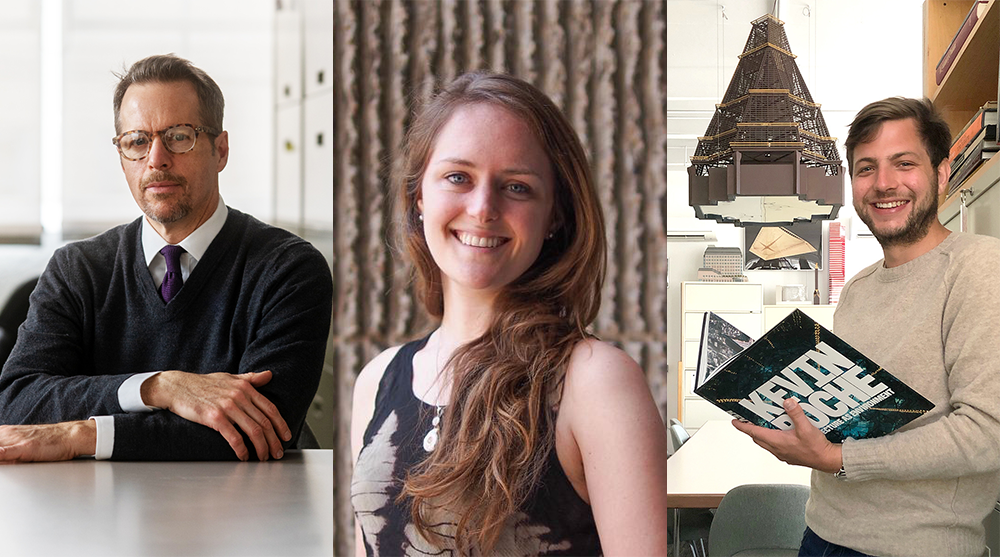We’d like to take the opportunity to introduce you to one of our Honorable mention winners for our “Modular Home Design Challenge 2021” competition – Gioia Montana Connell, Sam Golini and Eamon Roche from United States!

Eamon Roche, Gioia Montana Connell and Sam Golini from United States
Roche Modern is a cross-disciplinary design firm blending architecture, engineering, sculpture, and energy systems.
Established in 1950 as Eero Saarinen and Associates, the firm became Kevin Roche John Dinkeloo and Associates in 1966, and Roche Modern in 2020. As a small firm with a big reach, Roche Modern dares to imagine that we can create buildings, objects, and experiences that build on the lessons of our design past to create a healthy, sustainable, and inspired future.
We are a growing team of thirteen individuals based in New Haven, Connecticut, providing full-spectrum architectural services from design through project completion. From our seasoned architects that worked closely with our Pritzker Prize-winning principal Kevin Roche to our newest members fresh out of architecture school, we are bound by sensitivity to the natural environment and commitment to elevating the human condition through architecture.
The competition entry was produced under a new, exploratory arm of our firm that conducts investigations into material, place, life, and nature. This project is part of a broader, ongoing labour of love in the office, designed by the firm’s emerging architects in partnership with the firm’s principals and critiqued by senior designers.
Brief information about the projects that you/your company have been involved with. For instance, what scale have you focused on/preferred, any significant projects where the company/individuals have been involved?
Building upon decades of teamwork, the firm has deep expertise in both design and production, honed over the course of two hundred noteworthy, large-scale institutional, cultural, and commercial projects. The firm’s commitment to the environment and human experience dates back to the green roofs and terraces of the 1969 Oakland Museum in California, fast-forwarding to the recently completed award-winning LEED Platinum Capitol Crossing commercial/urban design project in Washington, DC.
The competition team brings additional expertise to the project, pulling on a number of professional and academic pursuits. Gioia Montana Connell brings a multiscalar environmental design approach based on her combined architectural and urban practice, honed while working at the Yale School of Architecture and the Yale School of the Environment on several natural infrastructure projects across the world. Sam Golini offers engineering, design, and fabrication expertise based on exploratory material projects—from automated xylophones to water-capture facades—conducted at Dartmouth Engineering and the Yale School of Architecture. Principal Eamon Roche contributes perspectives from development, mass production, and sculpture based on his experience in New York City-based construction and business development.
What does architecture mean to you and what is the role of an architect in your society?
The architecture we create is about people. The inhabitants, the community, and the larger population all need to be considered when a building project is embarked upon. The role and responsibility of the architectural profession is to listen, analyse, and create environments that respond to and affect all inhabitants. Since architecture has a rippling impact on people and the planet long after a project is completed and far beyond the building's footprint, we take extraordinary care with our designs. Making choices in dialogue with clients and users, with input from experts in engineering and the environment, and with a radically positive and inspired vision of our shared future helps our architectural practice to fulfil its potential.
Why do you participate in architecture competitions?
Architectural competitions allow the freedom to consider and develop far-reaching ideas that may not be possible in a traditional architectural project—yet could have a positive impact on realized projects. Architectural competitions bring many diverse voices and perspectives to the public realm on complex and significant subjects—subjects that require many viewpoints and a forum to discuss and illustrate ideas. In short, architectural competitions are public forums to investigate innovative ideas regarding the built environment that have the power to incrementally improve the status quo.
Our firm decides to undertake competitions to distil and visualize our base values as architects. We are in this profession because of its great yet hypogeal impact on society, nature, and climate. Competitions allow us to explore and share such commitments.
What advice would you give to individuals who struggle to decide whether it would be beneficial for them to participate in architecture competitions?
Every individual has a voice to be heard. As architects’ voices are expressed through the written and graphic definition of issues and related responses, architectural competitions are a great way to distil and share ideas. Entering a competition may not be about winning a prize, but more about having the opportunity to develop and express an idea or opinion on how to enhance the lives of people, protect the environment, and contribute to making the world a better place.
Competitions give a level platform for all ideas to be heard and considered. As the design problems of this world need innovation and representation from across experiences, the success of the profession needs this type of discourse.
Top 3 Reasons Why You Should Enter Architecture Competitions
Curious about the value of architecture competitions? Discover the transformative power they can have on your career - from igniting creativity and turning designs into reality, to gaining international recognition.
Learn more



























